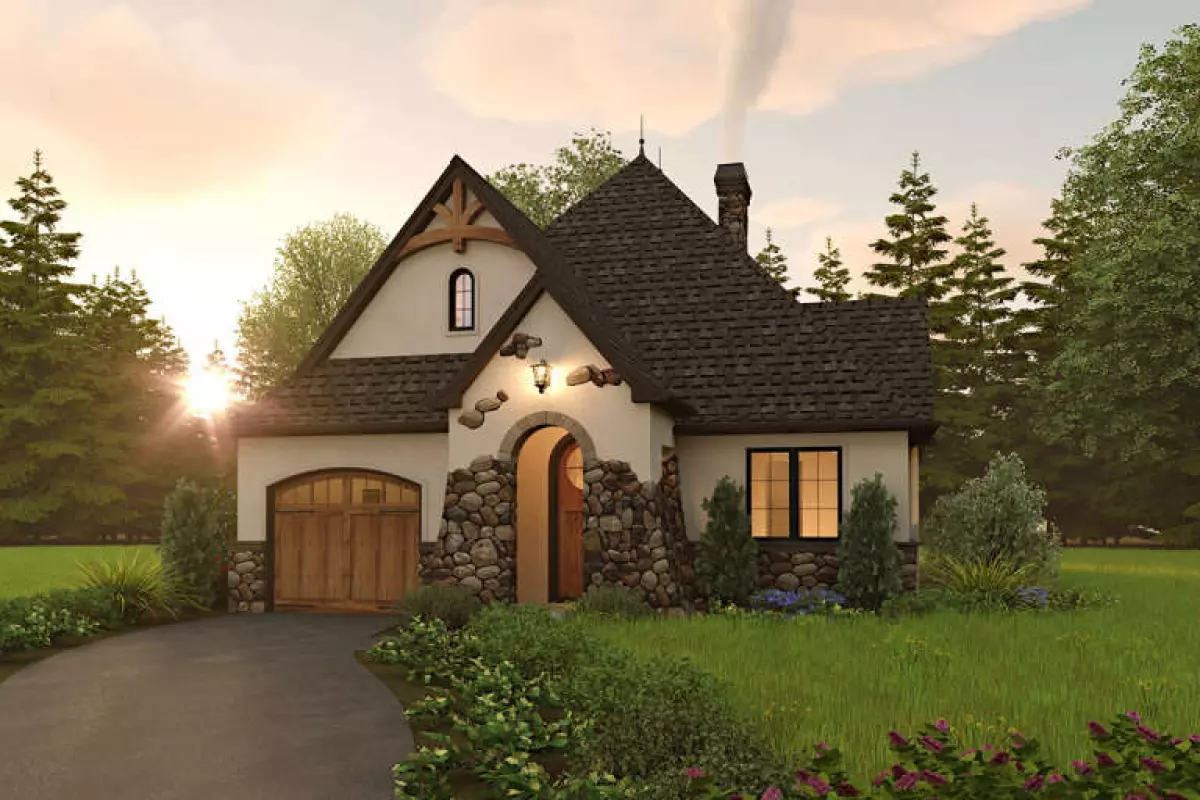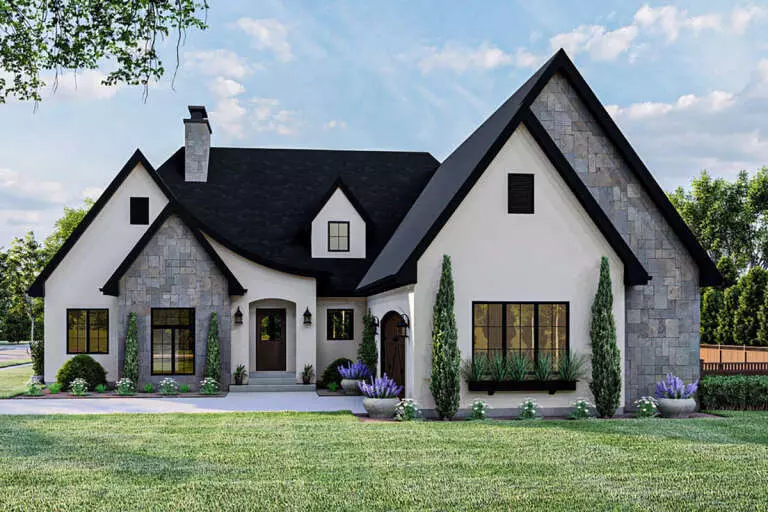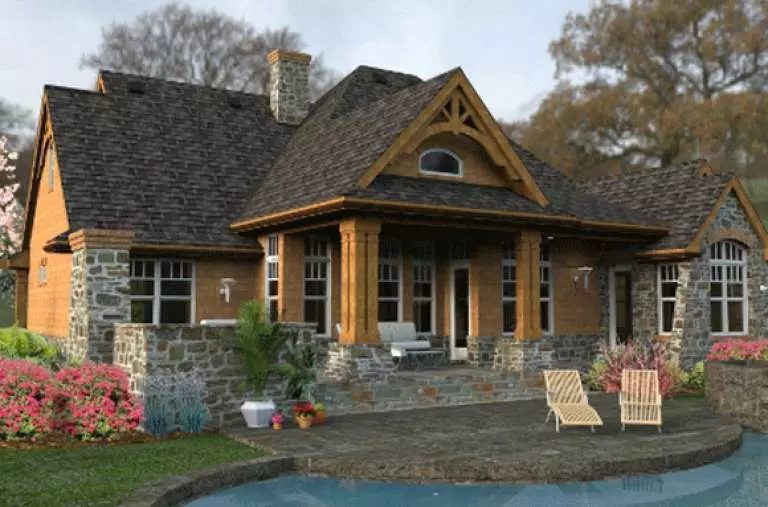If you're tired of the sleek lines and cold steel of modern home architecture, we have a delightful surprise for you - the Modern Tudor House. This classic design, dating back centuries, is experiencing a revival and it's better than ever before. The Modern Tudor House beautifully combines the romance and charm of the past with the contemporary needs of the present, resulting in a sophisticated blend of old-world charm and modern elegance.
The Essence of Classic Tudor Architecture
To truly appreciate the elegance of the Modern Tudor House, we must first explore its predecessor. Originating during the Tudor period in England, traditional Tudor house architecture is characterized by its distinct half-timbered framing, steeply pitched roofs, cross gables, and tall, narrow windows. These homes exude historical charm and European elegance, usually constructed with a timber frame filled with wattle and daub or brick.
 Image: A white, modern Tudor-style house with a white stone façade and dark wood shutters.
Image: A white, modern Tudor-style house with a white stone façade and dark wood shutters.
The Evolution of Design: What Makes a Modern Tudor House
While the Modern Tudor House retains the iconic architectural features of its predecessor, it also integrates contemporary materials and amenities. Today's Modern Tudor homes embrace the allure of the past while catering to the functional needs and design preferences of the present. The result is a harmonious blend of history and modernity.
 Image: A white, contemporary Modern Tudor-style house with a natural stone façade.
Image: A white, contemporary Modern Tudor-style house with a natural stone façade.
Adapting to Contemporary Aesthetics
Modern Tudor homes have gracefully adapted to contemporary design aesthetics, striking a balance between their historical roots and the demands of today's homeowners. Here are some notable adaptations:
- Updated Kitchen and Bathrooms: Modern Tudor homes boast state-of-the-art appliances, fixtures, and fittings. The fusion of modern amenities with Tudor-inspired elements creates a visually stunning and functional space.
- Blended Landscapes: Outdoor spaces in Modern Tudor-style house plans seamlessly combine English garden aesthetics with modern landscaping techniques. Outdoor kitchens and fire pits are popular additions.
- Versatility in Scale: Modern Tudors are no longer limited to sprawling estates; their design elements have been scaled to fit urban townhouses and suburban homes, showcasing their adaptability.
- Hybrid Design: Some modern Tudor homes blend Tudor features with other architectural styles like Modern, Craftsman, or Colonial, resulting in unique and captivating designs.
Integrating 21st-Century Technology and Sustainability
The Modern Tudor House integrates advanced technology and sustainability principles without compromising its charm and elegance. Here are a few examples of how owners have brought the past into the present:
- Energy-Efficient Glazing: Traditional lattice windows now feature double or triple glazing, reducing heat loss and energy bills.
- Smart Home Integration: Modern Tudor homes are equipped with advanced home automation systems, allowing homeowners to control lighting, heating, and security with their smartphones or voice-activated devices.
- Solar Integration: Homes can incorporate discreet solar panels or solar tiles into the roofing, harnessing renewable energy.
- Green Insulation: Modern Tudors embrace eco-friendly insulation materials like sheep's wool or recycled cellulose, improving energy efficiency while staying true to sustainability.
- LED Lighting: Modern Tudor houses utilize energy-efficient and long-lasting LED lights while maintaining ambient and period-appropriate lighting designs.
- Advanced Ventilation Systems: Smart thermostats and air purifiers are integrated into advanced HVAC systems, ensuring fresh indoor air and promoting efficiency.
- Low-flow Plumbing: Bathrooms and kitchens in modern Tudor homes feature water-saving fixtures, reducing water consumption without compromising functionality.
Essential Components of a Modern Tudor House
By incorporating modern materials, technologies, and design elements, Modern Tudor homes maintain their timeless beauty while meeting today's building standards and aesthetic demands. Here are some prevalent materials used:
- Engineered Wood: Provides the look of timber framing with increased durability and resistance to warping and pests.
- Fiber Cement Siding: Offers durability, fire resistance, and low maintenance, mimicking wooden boards or stucco.
- Vinyl or Aluminum Windows: Retain the classic tall, narrow appearance of Tudor windows with enhanced insulation and longevity.
- Modern Stucco: Upgraded version of traditional stucco, providing a smooth or textured finish between timber frames.
- Brick Veneer: Gives the appearance of solid brick without the associated thickness and weight.
- Composite Roofing: Imitates traditional clay tiles or wooden shingles and offers better insulation and durability.
- Steel Beams and Joists: Provides structural support without the bulk of traditional materials.
- Synthetic Stone: Offers the elegance and texture of natural stone at a fraction of the cost.
By skillfully blending these materials, modern Tudor homes embody the historical essence of the style while ensuring durability, energy efficiency, and compliance with modern building codes.
Open Floor Plans: Merging History with Modern Needs
Open floor plans have become a defining feature of modern architectural design, and their integration into modern Tudor houses exemplifies the elegant merging of history with today's lifestyle demands. The benefits of open floor plans in Modern Tudor homes include spatial fluidity, increased natural light, preservation of historical charm with adaptation to modern needs, and flexible design opportunities.
Tudor-style Landscaping and Outdoor Elements
The outdoor spaces and landscaping of Modern Tudor homes have adapted to contemporary lifestyles and aesthetics while drawing inspiration from their historical roots. Some transformations include functional gardens, integrated outdoor living spaces, simplified hedges and borders, automated irrigation systems, and the integration of recreational spaces.
 Image: The backyard of a modern Tudor house with a stone patio and pool.
Image: The backyard of a modern Tudor house with a stone patio and pool.
The Modern Tudor House represents the enduring appeal of a style that has gracefully weathered centuries. By blending the iconic elements of traditional Tudor architecture with contemporary materials, technologies, and design sensibilities, these homes seamlessly bridge the historical with the contemporary. They pay homage to the past while catering to the functional and aesthetic demands of the present. The Modern Tudor House is more than just a dwelling; it's a living, breathing emblem of timeless elegance woven with 21st-century sophistication.












